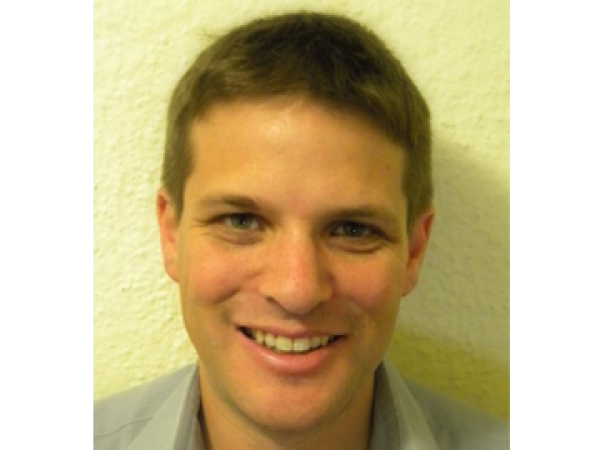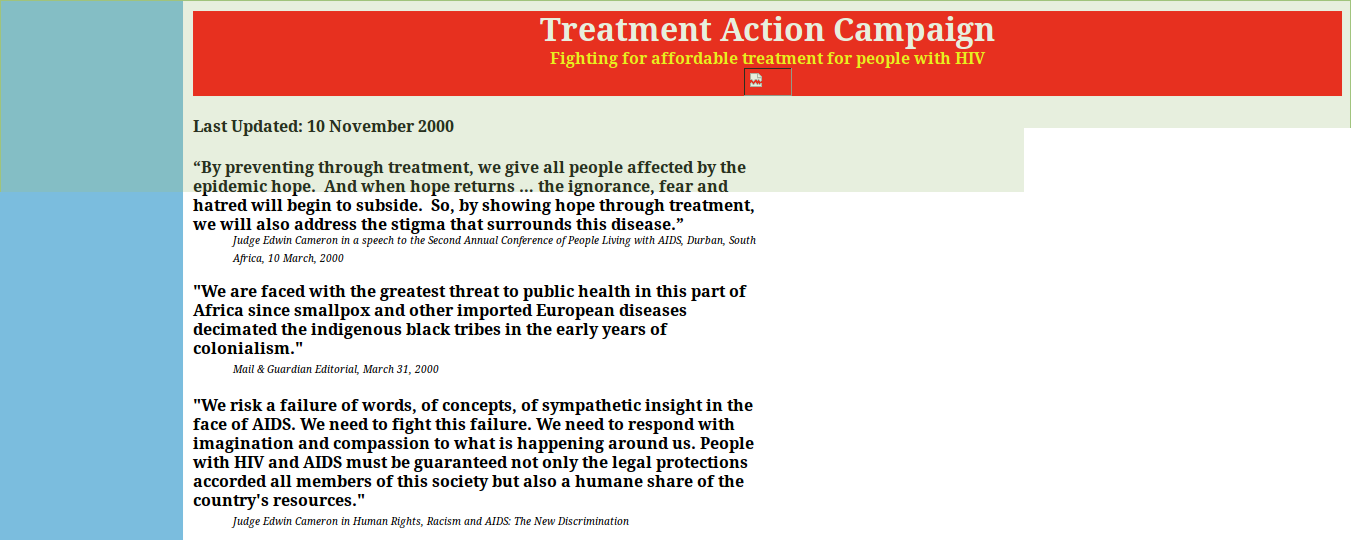Information Technology and the Treatment Action Campaign: successes and pitfalls

On 10 December 1998, about 10 people picketed outside St Georges Cathedral in Cape Town. They demanded that the state roll out a programme to reduce the risk of pregnant women transmitting HIV to their infants and for drug companies to lower their HIV medicine prices. This marked the modest beginning of the Treatment Action Campaign (TAC).
On 9 July 2000, 5,000 people marched under TAC’s banner to the opening of the International AIDS Conference in Durban. In a bit more than 18 months, TAC had grown into a substantial movement. It would go on to have even bigger marches, culminating in close to 15,000 people marching to Parliament on 14 February 2003, calling on the state to develop a plan to treat people with HIV.
Information Communication Technology (ICT) played an important part in TAC’s growth into a serious movement.
In early 2000, TAC didn’t have a proper website (it was a piggy-backed webpage hosted by another organisation) and it had no electronic newsletter. This was the case for most activist organisations in South Africa at the time.
So we set up an extremely simple website, but by the standards of the day, any website was an achievement. It is also possible we pioneered activist email newsletters in South Africa, which to this day is still called the TAC Electronic Newsletter. For it’s first couple of years the newsletter was run from a script on a computer in my office in the University of Cape Town’s Computer Science department. There was no automatic subscription mechanism; I manually added and deleted email addresses to the script, which was also responsible for handling my personal email; it was all very homemade, clunky and not always reliable. But it worked, most of the time. Even the ANC electronic newsletter only started in 2001, some time after TAC’s.

The TAC website in January 2001. An ugly duckling that never quite became a swan. Source: www.archive.org.
Because we were the only or one of the only organisations doing this at the time, the media learned about us and picked up our stories. The electronic newsletter helped spur intense media coverage on TAC. This made a huge difference to public awareness of our campaigns.
But it also allowed activists overseas, who were quite immersed in the Internet and email already, to learn more about TAC and our day-to-day activities. The electronic newsletter together with email helped us to organise the 9 July 2000 march under the banner of multiple organisations and call it a Global march, which it truly was because a large contingent of foreign activists took part in it and helped organise it.
March 2001 brought an even more effective use of ICT activism. Our website was the organising board for a global day of action against the pharmaceutical industry. Activist groups from around the world heeded our call to protest the approximately 40 pharmaceutical companies that had taken the South African government to court because of its amendments to the Medicines Act. Those events were first advertised on our website and our electronic newsletter and then once the events took place, photos and descriptions of them were put on the website and newsletter. Today that seems obvious; what effective organisation would not do that? But a decade ago that was unusual and exciting. The global pressure on the pharmaceutical industry was immense and within weeks it capitulated and withdrew its litigation. This level of global activist organising would have been impossible without websites, email and news lists.
Perhaps the most important part of TAC’s work has been its treatment literacy campaign. In this programme, branch members based in townships and, to a lesser extent, rural areas learn about HIV treatment and prevention, as well as complex political issues like drug patents. Now if for a moment we pretend that TAC’s work all took place in the late 80s or even mid-90s, I can’t see how the treatment literacy programme would have achieved anything close to what it did. It’s not that TAC’s rank and file members had access to ICT; unfortunately in the early 2000s few did and even today, few effectively use the Internet.
But what the Internet has given us are resources like the United States National Library of Medicine’s Pubmed, as well as immediate knowledge of new scientific developments from sources like the Lancet and New England Journal of Medicine. It is true that the Lancet and NEJM existed long before the Internet was popularised, but the paper editions are expensive. Now it is relatively simple for ordinary people —who are unable to access expensive journals— to exchange scientific papers over the Internet, as we have done since the early 2000s. (It is still not simple enough and still too expensive because not enough journals are open access, including the Lancet and NEJM.) This empowered a small subset of the organisation to be able to stay abreast of developments in HIV science, but then use that knowledge to inform the branch members about major developments and update our treatment literacy curriculum. Also, ICT helped us to communicate daily with highly treatment literate activists in the UK and US, which made a big difference to our ability to learn new developments in HIV. Developments in ICT have massively reduced the cost and complexity of international communication. The importance of that in our own HIV education was immense.
That’s the success story. But there are pitfalls too.
There’s no doubt about the value of the big social media applications —Facebook, Twitter, Google Plus, Whatsapp and Mxit— to help political mobilisation. Some of these played a significant role in the Arab revolutions. And let’s not forget about Wikileaks. Also, the Social Justice Coalition, in Cape Town, is exploring ways to use Twitter to improve the City’s service delivery in poor areas. They’re already having some success with this. Social media has incredible potential.
So what are the problems? There are several:
- Access: Although it’s improving, most people in South Africa still do not have consistent, effective access to the Internet including social media. Equal Treatment, TAC’s paper magazine, is still the organisation’s most important communication with its membership.

Equal Treatment, TAC’s print magazine, is still the organisation’s main communication to its membership.
Social media is not a replacement for human engagement, the community meeting or a protest. Social media helped organise the protests in Tahrir Square but social media was not the protest itself. Sending a tweet or posting on Facebook is not the same thing as a hunger strike or an act of civil disobedience. People often forget this: the virtual world is there to assist the non-virtual one, not vice-versa.
Beware the big Internet personality. I remember just prior to the big march in July 2000 when we met many of the international activists who had come to Durban to take part. One had seemed really important over email and on the Internet. When we met him in person though, we were disappointed. He was socially inept and lacked any sense of political strategy. He was a fish out of water in the real world.
Intellectual property: Every one of the social media applications I noted above is engulfed in intellectual property protection. Facebook is a particular problem. This isn’t just the concern of computer geeks. A great part of the beauty of the Internet is its open standards and freedom for those who have access to it to use it as they choose. Facebook has to some extent created a second proprietary Internet. It is beholden to its own business interests and the interests of states whose laws it must abide by, which often don’t coincide with the interests of ordinary people. Also, a big personal disappointment over the last decade is that free/open-source software has not caught onto desktop machines in the NGO world. The ubiquity of Microsoft Word is particularly problematic. Besides being no better for the average user than its open-source competitors, it is a technology that is unsuited to publishing on the Internet. (Website administrators dread receiving documents with complex formatting in Word format.)
ICT hopping: Beware the temptation to be an ICT activist rabbit who hops from one technology to the next thinking each will be the solution to some social problem. Most technologies fail. Be open but sceptical of new ones. Ask yourself: is it really useful to what we’re trying to achieve or is it only “cool”? If it’s only cool, it might be fun, but it might also waste a lot of your and other people’s time.
Complexity: When we developed the TAC website in 2000 it was simple, text-based and ugly. So was our newsletter. Hardly anyone cared. It was all cobbled together in a few hours. Today, you can’t get away with that. Everyone is on the internet and everyone has newsletters. Your website and newsletter have to be noticed and to be noticed they have to be good; they really have to be “cool”. Unfortunately the complexity of web development technology has exploded. To develop a comprehensive ICT solution for an activist organisation today you need skills in a website content management system, Javascript, perhaps either PHP or Python, CSS, SQL, mobile phone development, ever more sophisticated email list applications and integration with Twitter and Facebook. Few people have all these skills. Development is extremely expensive. Wrong ICT decisions can financially cripple social movements. Even though I’m a computer scientist (or perhaps because?) I’ve made some bad and costly ICT decisions over the years. It’s a very scary minefield out there. There are numerous charlatans and fly-by-nights in the ICT world. It might seem a cliche, but over and over again this has been proven to me: you can develop the most brilliant ICT solution —it could be the niftiest website ever thought of—, but if you don’t have users who will take responsibility for running it, it will fail.
Then there’s the trouble with legacy systems. The TAC website remains ugly today. That’s because it’s so absolutely ginormous, with thousands of documents and an important drug price tracking piece of software. Migrating it to a new pretty system is a huge challenge and one the organisation is currently struggling to sort out.
Oh dear the loons: There is a lot of excellent information on the web. But let’s not forget that Thabo Mbeki cited his reading activities on the Internet for his scepticism of HIV science that resulted in several hundred thousand avoidable AIDS deaths in South Africa. Alas, with the good there is also bad and the Internet is awash with junk. Countering the most harmful nonsense is an exhausting task.
ICT has revolutionised the world and it has helped people who struggle for human rights. It’s a great thing. But it is not an easy monster to deal with.
Geffen is the editor of GroundUp. He used to work for TAC and still sits on the organisation’s board. This is an edited version of a talk he delivered to the South African Sociological Association conference at the University of Cape Town in July 2012.
Next: Satire and the spear
Previous: Khayelitsha leader murdered

This article is licensed under a Creative Commons Attribution-NoDerivatives 4.0 International License.


